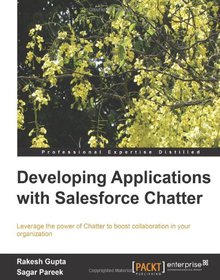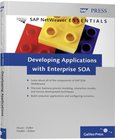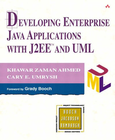Developing Applications with Salesforce Chatter

Book Details:
| Publisher: | Packt Publishing |
| Series: | Packt |
| Author: | Sagar Pareek |
| Edition: | 1 |
| ISBN-10: | 1782171169 |
| ISBN-13: | 9781782171164 |
| Pages: | 130 |
| Published: | Nov 25 2013 |
| Posted: | Nov 19 2014 |
| Language: | English |
| Book format: | |
| Book size: | 10.46 MB |
Book Description:
Leverage the power of Chatter to boost collaboration in your organization Overview Understand Salesforce Chatter and its architecture. Configure and set up Chatter for your organization Improve Chatter features by utilizing Apex and Visualforce Pages Discover the new Chatter REST API for developers A step-by-step guide to develop a fully functional Chatter application with chatter data cleaning concept In Detail Salesforce Chatter provides a secure environment that enables you to stay connected to your customers. Chatter simplifies and speeds-up the process of sharing ideas, documents, and anything else with your co-workers instantly. Using Chatter, you can perform any action from anywhere and make your business more social. "Developing Applications with Salesforce Chatter" starts by covering the basics of Salesforce Chatter, Chatter license types, and its effect on ROI. It then discusses how to configure Chatter and various sections to customize it. Further, it walks through the Chatter Data cleaning as well as the basics of REST API and oAuth. This book will cover everything you need to know about Salesforce Chatter configuration and customization. "Developing Applications with Salesforce Chatter" allows you to improve collaboration in your organization. The book covers many features such as Chatter messenger, commenting on status, uploading and sharing files, polls and Chatter actions. This book also teaches you how to configure and customize Chatter by using Apex and Visualforce pages for high productivity. This book is a hands-on guide focused on the configuration and customization of Chatter. This book will act as both a reference for experienced developers and a customization guide for newbies who want to set up Chatter for their organization. This book also contains various sections that demonstrate how to improve Chatter's functionality by using Apex and Visualforce pages. By the end of this book, you will be able to successfully configure and customize Salesforce Chatter for your organization quickly and efficiently. What you will learn from this book Understand how Chatter function can be improved by utilizing Apex and Visualforce Pages. Boost collaboration in your organisation Explore various Chatter configurations and customizations Learn about the Chatter Publisher Action Install and configure Chatter desktop and mobile Extrapolate how to add topics, bookmarks, and favourites in your Chatter post Discover various method for Chatter data cleaning Get familiar with the REST API, oAuth, and various tokens Approach This book follows a hands-on approach which will help newbies to easily understand the concepts of Salesforce Chatter and its configuration easily. For advanced users, this book has few approaches and code snippets to help you make Salesforce Chatter more responsive and productive. Having fundamental knowledge of Apex and Visualforce pages will be helpful. Who this book is written for This book is intended for people who are newbies in the Salesforce arena and who want to boost collaboration in their organization using Chatter. After reading this book, you will be able to configure Chatter all on your own, but for customization tasks such as improving the user interface, you will need a basic understanding of Apex and Visualforce pages.
Download Link:
Related Books:
Developing Applications With Enterprise SOA
In this innovative book, you'll find unique insights and techniques for developing applications using SAP's Enterprise SOA tools. And, you'll learn what application development and configuring service-based applications will be like in future system landscapes. The book begins with an overview of the basics, including Middleware SOA system requirements, the modeling tools available, and how to model Enterprise Services. Then, you'll move on to four in-depth chapters that detail the practical uses of the tools, such as how to develop Enterprise Services, which interaction models are supported, and how to deploy them. You'll finish by taking a step-by-step tour of the development of a consumer application involving Enterprise Services and the configura...
Developing Enterprise Java Applications with J2EE and UML
The Java 2 Platform Enterprise Edition (J2EE TM) offers great promise for dramatically improving the way that enterprise applications are built, and organizations that have adopted the J2EE are gaining a competitive advantage. The industry-standard Unified Modeling Language (UML) has helped countless organizations achieve software success through visual modeling. Together, the UML and J2EE form a powerful set of tools, but the intricacies involved with using them in tandem are considerable. While UML is highly effective for specifying, designing, constructing, visualizing, and documenting software systems, J2EE offers enterprise developers a simplified, component-based approach to application development. However, when using the two technologies to...
POJOs in Action
Developing Enterprise Applications with Lightweight Frameworks
The standard platform for enterprise application development has been EJB but the difficulties of working with it caused it to become unpopular. They also gave rise to lightweight technologies such as Hibernate, Spring, JDO, iBATIS and others, all of which allow the developer to work directly with the simpler POJOs. Now EJB version 3 solves the problems that gave EJB 2 a black eye-it too works with POJOs. POJOs in Action describes the new, easier ways to develop enterprise Java applications. It describes how to make key design decisions when developing business logic using POJOs, including how to organize and encapsulate the business logic, access the database, manage transactions, and handle database concurrency. This book is a new-generation Java a...
2007 - 2021 © eBooks-IT.org



